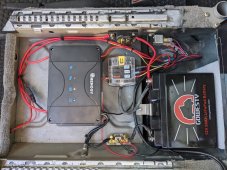I just finished installing a small LiFePo4 house battery and 30 amp DC DC charger under the seat of my Vanagon. The system works well for my needs.

I do some cold weather camping, and my understanding is that these batteries should not be charged in temps below 32 degrees F.
I am thinking about the linked heating pad as a solution. I'd wire in some kind of temp controlled relay for upper and lower temp cut in/out.
Question is, how to mount the pad and how close to the battery? Direct contact? Mount it on a piece of aluminum or something and get it within an inch or so in the battery box?? Any experience out there?

I do some cold weather camping, and my understanding is that these batteries should not be charged in temps below 32 degrees F.
I am thinking about the linked heating pad as a solution. I'd wire in some kind of temp controlled relay for upper and lower temp cut in/out.
Question is, how to mount the pad and how close to the battery? Direct contact? Mount it on a piece of aluminum or something and get it within an inch or so in the battery box?? Any experience out there?



